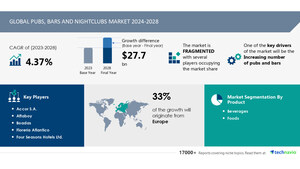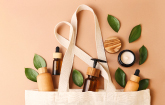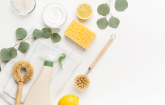NEW YORK, Sept. 26, 2024 /PRNewswire/ -- Report on how AI is redefining market landscape- The global bar soap market size is estimated to grow by USD 8.76 billion from 2024-2028, according to Technavio. The market is estimated to grow at a CAGR of 4.36% during the forecast period. Growing hygiene awareness is driving market growth, with a trend towards growing use of sustainable materials in soap bar packaging. However, stringent government regulations and standards related to bpc products poses a challenge. Key market players include Beaumont Products Inc., CST Soap, Dr. Woods Products, Godrej Consumer Products Ltd., Henkel AG and Co. KGaA, Himalaya Global Holdings Ltd., ITC Ltd., John Drury and Co. Ltd., Johnson and Johnson Services Inc., LOreal SA, Manos Soap Co., Natura and Co Holding SA, Neals Yard Ltd., Reckitt Benckiser Group Plc, The Original Bradford Soap Works Inc., The Procter and Gamble Co., Twincraft Skincare, Unilever PLC, Vanguard Soap, and VVF Ltd..
AI-Powered Market Evolution Insights. Our comprehensive market report ready with the latest trends, growth opportunities, and strategic analysis- View your snapshot now
Forecast period |
2024-2028 |
Base Year |
2023 |
Historic Data |
2018 - 2022 |
Segment Covered |
Material (Synthetic and Natural), Distribution Channel (Offline and Online), and Geography (APAC, North America, Europe, South America, and Middle East and Africa) |
Region Covered |
APAC, North America, Europe, South America, and Middle East and Africa |
Key companies profiled |
Beaumont Products Inc., CST Soap, Dr. Woods Products, Godrej Consumer Products Ltd., Henkel AG and Co. KGaA, Himalaya Global Holdings Ltd., ITC Ltd., John Drury and Co. Ltd., Johnson and Johnson Services Inc., LOreal SA, Manos Soap Co., Natura and Co Holding SA, Neals Yard Ltd., Reckitt Benckiser Group Plc, The Original Bradford Soap Works Inc., The Procter and Gamble Co., Twincraft Skincare, Unilever PLC, Vanguard Soap, and VVF Ltd. |
Key Market Trends Fueling Growth
The bar soap market is witnessing innovation in soap packaging, with new designs and materials gaining popularity. ITC's Savlon Glycerin Soap recently introduced eco-friendly packaging using 70% recycled plastic material in its PET film wrapper. This shift towards sustainable packaging is a response to increasing consumer concern for the environment. The use of Post-Consumer Recycled (PCR) material, derived from previously used plastics, significantly reduces plastic waste and supports a circular economy. This trend towards sustainable packaging is a key driver for the growth of the global bar soap market.
The Bar Soap Market is witnessing notable trends in various sectors, including dish washing and body cleaning. Consumers are increasingly preferring natural and vegan options, with lemongrass, rosemary, tea tree oil, and eucalyptus being popular choices for their unique scents and health benefits. For those with scalp eczema or sensitive skin, natural and clean products free from GMOs, gluten, and soy are in high demand. Eco-friendly and plant-based soaps, available in various colors and fragrances, are gaining traction in beauty care and skincare routines. Brands are focusing on moisturizing ingredients like shea butter, cocoa butter, and coconut oil, as well as essential oils and exfoliating properties. Specialty bar soaps, such as those from OilBlends, are increasingly popular for their unique offerings. Offline stores continue to be a significant sales channel, but online retailer platforms are also seeing growth due to convenience and accessibility. Neutrogena and Organic Soap are major players in the synthetic and organic soap segments, respectively. Consumers are embracing multi-step routines and daily rituals for personal hygiene and self-care, leading to increased demand for a wide range of bar soap offerings. Plastic-free clamshells and eco-friendly packaging are also becoming essential considerations for environmentally-conscious consumers.
Insights on how AI is driving innovation, efficiency, and market growth- Request Sample!
Market Challenges
- In the US, the Food and Drug Administration (FDA) strictly regulates the use and labeling of chemical ingredients in beauty and personal care (BPC) products, including bar soaps. The FDA enforces regulations under the Federal Food, Drug, and Cosmetic Act (FD&C Act) and the Fair Packaging and Labeling Act (FPLA). Bar soap vendors must comply with these regulations, which include listing all ingredients on labels and adhering to prescribed limits for chemical ingredients in liquid hand soaps to avoid potential health hazards. Some bar soap ingredients, such as parabens, fragrances, and phthalates, may be harmful and must be disclosed. Manufacturers face challenges in penetrating the market due to these regulations, as well as the requirement to avoid making false claims about their products. Despite these challenges, the global bar soap market continues to grow, driven by consumer demand for effective and affordable personal hygiene solutions.
- The Soap Market faces several challenges in catering to diverse consumer needs. Stuck drawers due to solid soap bars pose an issue for consumers. Glycerin-free soaps can cause dry skin and sensitivities like eczema. Bacteria growth and maintaining pH levels are concerns in commercial places like Schools, Colleges, Fitness centers, Restaurants, and Hotels. Cleaning agents and hygiene products like Hand wash, Sanitizers, and Surfactants require careful formulation to avoid allergic reactions. Raw materials like sodium laurel sulfate and chemical emulsifiers are commonly used but may not appeal to consumers seeking natural ingredients. Organic bar soaps made from natural lipid layers, clay, oil cleansing, and herbal powders like gram flour, orange peel powder, and whole wheat flour are gaining popularity. Home remedies using natural ingredients offer an alternative to synthetic soaps. The Personal care market, Beauty salons, Specialty stores, Pharmacies, and Luxury hotels cater to this demand. The Soap Market continues to evolve, balancing consumer preferences, hygiene, and affordability.
Insights into how AI is reshaping industries and driving growth- Download a Sample Report
Segment Overview
This bar soap market report extensively covers market segmentation by
- Material
- 1.1 Synthetic
- 1.2 Natural
- Distribution Channel
- 2.1 Offline
- 2.2 Online
- Geography
- 3.1 APAC
- 3.2 North America
- 3.3 Europe
- 3.4 South America
- 3.5 Middle East and Africa
1.1 Synthetic- In the global bar soap market, synthetic soaps held the largest share in 2023. Consumers prefer synthetic liquid hand soaps due to their bacteria-killing properties, primarily from chemically formulated detergents like sodium laureth sulfate (SLS). However, concerns over potential irritants and allergens have led some consumers to seek alternative options. The use of synthetic chemicals and additives has also raised environmental and health concerns. Despite these challenges, synthetic bar soaps remain popular due to their affordability and efficiency in producing lather and removing dirt. The COVID-19 pandemic further boosted demand due to their fast-acting properties against microorganisms. Vendors are responding by sourcing local raw materials to lower costs and meet increased demand. This trend is expected to continue, contributing to the growth of the synthetic segment in the bar soap market.
Download complimentary Sample Report to gain insights into AI's impact on market dynamics, emerging trends, and future opportunities- including forecast (2024-2028) and historic data (2018 - 2022)
Research Analysis
The bar soap market encompasses the production and sale of solid cleansing products, also known as bars. The cleansing cycle begins with the extraction of raw materials from plants and the processing of unrefined components into natural substances. These substances are then combined with surfactants to create the base soap. Commercial places, schools, colleges, fitness centers, restaurants, and various institutions are significant consumers of bar soaps due to their hygiene standards. Cleaning agents also use bar soaps for various cleaning purposes. Consumers prefer bar soaps for their affordability and long shelf life. Natural ingredients and organic bar soaps are gaining popularity due to the growing trend towards healthier and more sustainable personal care products. The soap market includes both offline stores and online retailer channels. Fluid cleansers, shavings, and sanitizers are alternative products in the market. The raw materials used in soap production include various oils, fats, and alkali. The global soap market size is expected to grow significantly due to increasing demand for personal hygiene products and rising awareness about the benefits of natural ingredients.
Market Research Overview
Bar soaps, a staple in personal hygiene and cleaning, undergo a cleansing cycle that transforms unrefined components, such as plants and natural substances, into effective cleansers. These soaps come in various forms, including shavings, and are used to remove dirt, insects, and other impurities from skin, hands, and surfaces. Water solutions, often infused with essential oils and herbal extracts, enhance the cleansing experience. Containers, rings, and seams can sometimes pose challenges, but glycerin and other natural ingredients help maintain skin health for consumers with dry skin or sensitivities like eczema. Commercial places, schools, colleges, fitness centers, restaurants, and cleaning agents all rely on bar soaps for hygiene purposes. The soap market encompasses a wide range of products, from hand wash and sanitizers to raw materials like surfactants, chemical emulsifiers, and sodium laurel sulfate. Consumers seek out natural and organic bar soaps, as well as vegan, clean, GMO-free, gluten-free, soy-free, and recyclable products, for their skin, beauty care, and eco-friendly benefits. Ingredients like clay, oil cleansing, and herbal powders are popular in natural and home remedies. Synthetic alternatives exist, but many prefer the natural, fragrant, and therapeutic qualities of essential oils like lemongrass, rosemary, tea tree oil, and eucalyptus. Bar soaps are essential for bathing, dish washing, and body cleaning, catering to various needs and preferences.
Table of Contents:
1 Executive Summary
2 Market Landscape
3 Market Sizing
4 Historic Market Size
5 Five Forces Analysis
6 Market Segmentation
- Material
- Synthetic
- Natural
- Distribution Channel
- Offline
- Online
- Geography
- APAC
- North America
- Europe
- South America
- Middle East And Africa
7 Customer Landscape
8 Geographic Landscape
9 Drivers, Challenges, and Trends
10 Company Landscape
11 Company Analysis
12 Appendix
About Technavio
Technavio is a leading global technology research and advisory company. Their research and analysis focuses on emerging market trends and provides actionable insights to help businesses identify market opportunities and develop effective strategies to optimize their market positions.
With over 500 specialized analysts, Technavio's report library consists of more than 17,000 reports and counting, covering 800 technologies, spanning across 50 countries. Their client base consists of enterprises of all sizes, including more than 100 Fortune 500 companies. This growing client base relies on Technavio's comprehensive coverage, extensive research, and actionable market insights to identify opportunities in existing and potential markets and assess their competitive positions within changing market scenarios.
Contacts
Technavio Research
Jesse Maida
Media & Marketing Executive
US: +1 844 364 1100
UK: +44 203 893 3200
Email: [email protected]
Website: www.technavio.com/
SOURCE Technavio

WANT YOUR COMPANY'S NEWS FEATURED ON PRNEWSWIRE.COM?
Newsrooms &
Influencers
Digital Media
Outlets
Journalists
Opted In






Share this article